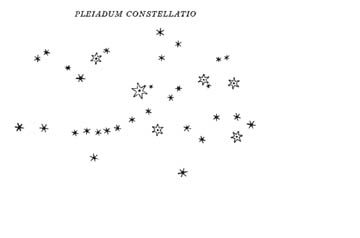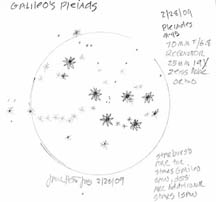Galileo’s sketch of the Pleiades was published in Sidereus Nuncius in 1610.
Galileo identified four levels of stellar magnitude. He represented the six naked eye stars he could see with a large star symbol. These 6 stars were listed in Ptolemy’s Star Catalog. Next come seven stars represented by larger than average star symbols. Twenty-one average sized star symbols are the next magnitude and two smaller than average star symbols complete the sketch. Galileo saw thirty-six stars in the Pleiades.
My Pleiades sketch, using my Televue Ranger and a 25mm Zeiss Abbe Ortho eyepiece shows the Pleaides I was able to see at 19x. I saw the familiar 7 brightest members (the 7 sisters) and an additional 39 stars. I tried to make the size of each star sketch match the changes in magnitude, just like Galileo did.
Several of Galileo’s hand drawn sketches of the Pleiades, along with a diagram of Cassiopea, can be found in Volume 3, page 962 of the National Edition of Galileo’s works and are linked below:
Volume 3, page 962 of the National Edition of Galileo’s works
A page from Sidereus Nuncius showing Galileo’s Pleiads
Seven Sisters Overhead: Native American Legends of the Pleiades is an article I wrote for Fast Forward, a Marin County, CA Kids newspaper. It features a charming sketch of the Pleiades by my mom, Barbara Miller.
Here is a wide field astrophoto of the Pleiades or M-45 taken by my hubby Morris Jones.

